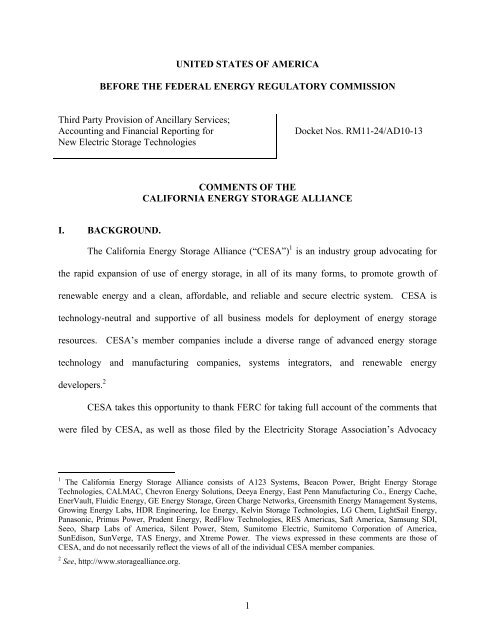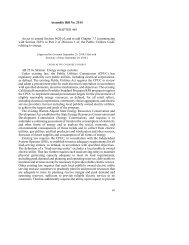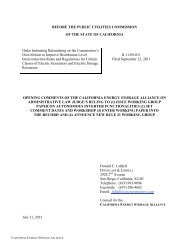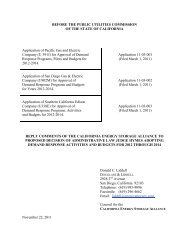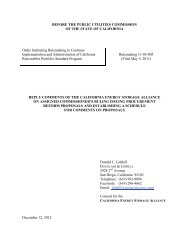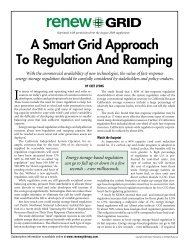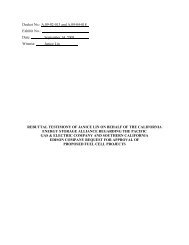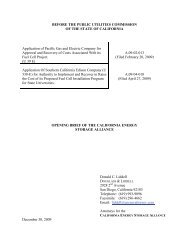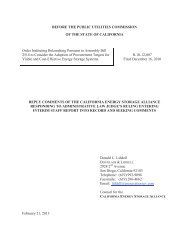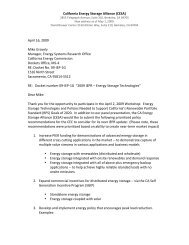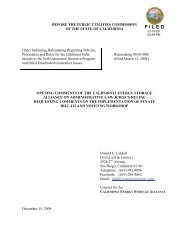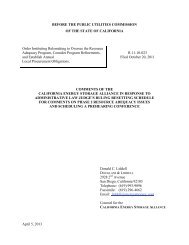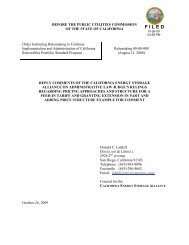FERC Third Party Ancillary Services and Storage NOPR Comments
FERC Third Party Ancillary Services and Storage NOPR Comments
FERC Third Party Ancillary Services and Storage NOPR Comments
You also want an ePaper? Increase the reach of your titles
YUMPU automatically turns print PDFs into web optimized ePapers that Google loves.
power analysis based on a different geographic market or different fleet of resources than thosethat are analyzed to determine market power for sales of energy <strong>and</strong> capacity. <strong>FERC</strong> correctlyproposes to require each public utility transmission provider to post information on its OASISdisclosing the aggregate amount of each ancillary service that it has historically required,including any geographic limitations it must manage in meeting its ancillary servicerequirements.The optional market power screen for an ancillary service can compare the amount ofcapacity that a seller can dedicate to providing the ancillary service in the relevant geographicmarket with the buyer’s reported aggregate requirement for that ancillary service, <strong>and</strong> sellerswhose available capacity is no more than 20% of the reported aggregate requirement for anancillary service would be entitled to a rebuttable presumption that they lack horizontal marketpower for the particular kind of ancillary service.CESA supports <strong>FERC</strong>’s optional power screen proposal <strong>and</strong> recommends certain specificdetails that should be included in the proposed OASIS reporting requirement to capture themethod that the balancing area employs to determine reserve requirements <strong>and</strong> support anyproposed optional market power screen. The public utility should provide seasonal <strong>and</strong> time-ofdayrequirements for each ancillary service instead of a single average reserve procurementamount of each year. Calculation of the percentage of the relevant reported aggregaterequirement for an ancillary service for the optional market power screen should be done on anannual <strong>and</strong> seasonal peak basis, as is done currently for pivotal supplier <strong>and</strong> market shareanalysis. CESA also strongly urges <strong>FERC</strong> not to characterize the optional market screen as“experimental” because doing so would undermine the goal of reforming the rules to removebarriers to entry.4
MW may be the same, buyers need to purchase more total capacity from the slower resource inorder to acquire the same amount of regulation service. In other words, 1 MW of fast can't bepaid more than 1MW of slow even though it is recognized as being more valuable by anyst<strong>and</strong>ard.Today, in the non-RTO/ISO regions the Schedule 3 Contract Price for RegulatingReserve Service is stated in units of $/kW/hour or $/kW/Month <strong>and</strong> the Billing Factor is basedon the transmission customers total load. This data can be insufficient for a third-party supplierto reflect a resource’s performance in comparing whether the third-party supplier’s costs arebelow the transmission provider’s OATT Schedule 3 rate. CESA therefore recommends that<strong>FERC</strong> provide specific guidance on the cost-based data to be included in both transmissionproviders <strong>and</strong> third party seller’s regulation schedules to ensure that costs are evaluated on atruly comparable basis. <strong>FERC</strong> should require that the transmission provider’s schedules <strong>and</strong>third-party seller’s schedules include the following minimum data: (a) current total capacity toprovide regulation, (b) ramp-rate of its regulating resource, (c) performance accuracy <strong>and</strong>formula for calculating performance accuracy, <strong>and</strong> (d) cost of regulation per unit of reliability.CESA’s recommended schedule changes would clearly identify the individual regulationcosts of each resource based on its performance characteristics, thus ensuring that the benefitsgained by procuring regulation from resources that can respond to regulation signals with greaterspeed <strong>and</strong> accuracy are reflected in the costs used to compare suppliers. Allowing transparentcomparison <strong>and</strong> evaluation of resources will ensure the lowest cost resources are identified, <strong>and</strong>reduce costs to customers <strong>and</strong> the absolute amount of required capacity.CESA also supports <strong>FERC</strong>’s proposal to allow ancillary service sales at prices not toexceed the highest public utility transmission provider OATT rate within the relevant geographic6
purchases from third-parties, using resources with speed <strong>and</strong> accuracy characteristics that differfrom the fleet of resources otherwise being used for regulation <strong>and</strong> frequency response.Because fast-ramping resources provide more regulation value to the transmission systemper MW than slower-ramping resources, if a transmission customer chooses to self-supplyregulation from a resource that has a faster ramp-rate than the transmission provider’s regulationresource it should be allowed to purchase less regulation capacity. If a variable resource choosesto self-supply its regulation reserve capacity using a fast-ramping energy storage facility, itshould be able to self-supply a lower volume of regulating reserve capacity than if it selfsuppliedfrom a slow-ramping traditional resource. If two resources can provide comparableregulation service with different levels of capacity, supplying different levels of capacity shouldclearly be allowed.CESA recommends that each transmission provider increase market transparency with anexplanation of how it sets its regulation requirement. This explanation should include adescription of the calculation, the metric which is used to set the requirement, the averageperformance of the existing regulation assets <strong>and</strong> sufficient data for a third party to reproduce theresults, including posting ACE data on its OASIS reporting. CESA further recommendsrequiring transmission providers to include in their accounting <strong>and</strong> evaluation of their need forspeed <strong>and</strong> accuracy sufficient detail <strong>and</strong> transparency on the units they currently have in place,including ramp-rate <strong>and</strong> accuracy.C. Extending the Goals of Order No. 755 to a Public Utility That is Purchasing<strong>Ancillary</strong> <strong>Services</strong> to Satisfy its Own OATT Requirements to Offer <strong>Ancillary</strong><strong>Services</strong> to its Own Customers<strong>FERC</strong> must adopt reforms to extend the goals of Order No. 755 to a public utility’s ownsupply of frequency regulation to satisfy its own OATT obligation because third party sales to apublic utility that is purchasing ancillary services to satisfy its own OATT requirements to offer8
ancillary services to its own customers represents the most significant potential market for salesof ancillary services in non-RTO/ISO regions. Currently, there is nothing in the proposed rulesthat would encourage public utility transmission owners to improve the speed <strong>and</strong> accuracy oftheir own or contracted fleet of frequency regulation resources, even though <strong>FERC</strong> found inOrder No. 755 that the potential to lower costs to consumers by reducing the amount of capacitythat must be procured to provide frequency regulation <strong>and</strong> a potential secondary benefit oflowering energy market prices by allowing displaced generators to operate at more stable output.CESA recommends that <strong>FERC</strong> consider allowing performance-based rate treatment forpublic utility investments <strong>and</strong> contracts with third-party ancillary service providers that allow thepublic utility to reduce the total capacity <strong>and</strong> cost of providing regulation service whilemaintaining the same level of reliability. <strong>FERC</strong> can therefore justify allowing a performancebasedincentive rate adder to the amount public utility transmission providers can recoverthrough rates.D. Accounting <strong>and</strong> Reporting for Energy <strong>Storage</strong> Operations1. Proposed Accounting RequirementsCESA welcomes the updating of the Uniform System of Accounts to make the costreporting of energy storage more transparent. The changes to the accounting requirementsproposed by <strong>FERC</strong> will provide sufficiently transparent information on the activities <strong>and</strong> costs ofnew energy storage operations.i. <strong>FERC</strong> Proposal. Where public utilities seek to simultaneously recovercosts under cost-based <strong>and</strong> market-based rates, the Commission proposes that the entities berequired to account for <strong>and</strong> report their operations of the cost-based portion of the rates. TheCommission proposes that public utilities currently providing jurisdictional services <strong>and</strong>recovering costs of the services under market-based rates that have been granted waiver of the9
accounting <strong>and</strong> reporting requirements that seek recovery of a portion of service costs undercost-based rates, be required to forego the previously issued waiver <strong>and</strong> account for <strong>and</strong> report allcost <strong>and</strong> operational information to the Commission. The Commission seeks comment onwhether there should be a percentage of cost recovery threshold or other determining factor thattriggers the accounting <strong>and</strong> reporting obligations in this situation.CESA ResponseCESA agrees that in instances where public utilities seek to simultaneously recover costsunder cost-based <strong>and</strong> market-based rates, the entities be required to account for <strong>and</strong> report theiroperations of the cost-based portion of the rates in accordance with <strong>FERC</strong>’s accounting <strong>and</strong>reporting requirements to facilitate development <strong>and</strong> monitoring of the cost-based portion of therates. CESA agrees that public utilities currently providing jurisdictional services <strong>and</strong> recoveringcosts of the services under market-based rates that have been granted waiver of the accounting<strong>and</strong> reporting requirements that seek recovery of a portion of service costs under cost-based ratesbe required to forego the previously issued waiver <strong>and</strong> account for <strong>and</strong> report all cost <strong>and</strong>operational information to <strong>FERC</strong> in accordance with its accounting <strong>and</strong> reporting requirements.This will enhance transparency <strong>and</strong> facilitate development <strong>and</strong> monitoring of the cost-basedportion of the rates.CESA suggests that there should not be a percentage of cost recovery threshold thattriggers the accounting <strong>and</strong> reporting obligations in situations of multiple cost recovery. CESAalso suggests that <strong>FERC</strong> allow competitive solicitations in conjunction to assist in partitioning anenergy storage asset. For example, a storage asset may be capable of simultaneously providingtwo distinct functions, one traditionally cost-based use, <strong>and</strong> another generally market-based. Autility would then issue a competitive solicitation for solely the cost-based use. The winning10
third party would be obligated to provide the cost-based service as contracted, <strong>and</strong> would be paidultimately through a rate-based mechanism. The third party would then be free to utilize theremaining unobligated function in another solicitation or a market. CESA recommends that apublic utility that uses competitive solicitations in this manner should not be required to foregoany reporting <strong>and</strong> accounting waivers.2. Electric Plant Accountsi. <strong>FERC</strong> Proposal. The Commission proposes creating a new electric plantaccount <strong>and</strong> amending two existing electric plant accounts to record the installed cost of energystorage equipment owned by public utilities <strong>and</strong> licensees. Specifically, the Commissionproposes a new account within the production functional classification <strong>and</strong> amending existingaccounts within the transmission <strong>and</strong> distribution functional classifications.The proposed plant account would be Account 348, Energy <strong>Storage</strong> Equipment-Production, <strong>and</strong> the accounts we propose to amend are existing Account 351, [Reserved], <strong>and</strong>Account 363, <strong>Storage</strong> Battery Equipment. Account 351 is a reserve account <strong>and</strong> is not currentlybeing used. The Commission proposes to rename Account 351 as “Energy <strong>Storage</strong> Equipment-Transmission.” The Commission proposes to amend the instructions of Account 363 to exp<strong>and</strong>the type of energy storage assets that can be recorded in the account <strong>and</strong> to recognize the uniqueoperating characteristics of energy storage assets, which may provide services other than onlysupplying electricity. In addition, the Commission proposes to rename Account 363 as Energy<strong>Storage</strong> Equipment-Distribution.The Commission proposes that the instructions to the accounts provide for recording thecost of installed energy storage assets based on the function or purpose the equipment serves.The Commission proposes that in instances where an energy storage asset is used to perform11
more than one function or purpose, the cost of the asset shall be allocated among production,transmission, <strong>and</strong> distribution plant based on the services provided by the asset <strong>and</strong> the allocationof the asset’s cost through cost based rates approved by a relevant regulatory agency, federal orstate.CESA ResponseCESA agrees with <strong>FERC</strong>’s proposal to create a new electric plant account within theproduction functional classification <strong>and</strong> amend two existing electric plant accounts within thetransmission <strong>and</strong> distribution functional classifications to record the installed cost of energystorage equipment owned by public utilities. By establishing a dedicated plant account forstorage equipment costs for each of the three uses of plants, <strong>FERC</strong> will ensure appropriatetransparency for storage cost accounting.CESA agrees that the instructions to the accounts should provide for recording the cost ofinstalled energy storage assets based on the function or purpose the equipment serves. CESAagrees that where an energy storage asset is used to perform more than one function or purpose,the cost of the asset should be allocated among production, transmission, <strong>and</strong> distribution plantbased on the services provided by the asset <strong>and</strong> the allocation of the asset’s cost through costbased rates approved by a relevant regulatory agency, federal or state.ii.<strong>FERC</strong> Proposal. The Commission proposes that the original cost of an energystorage asset <strong>and</strong> other amounts associated with the original cost of the asset (e.g., accumulateddepreciation expenses <strong>and</strong> accumulated deferred income taxes) initially allocated to specific<strong>FERC</strong> accounts <strong>and</strong> later reallocated to other <strong>FERC</strong> accounts based on services provided by theasset <strong>and</strong> cost recovery be accounted for in accordance with Electric Plant Instruction No. 12,Transfers of Property. The Commission finds that if the costs of an energy storage asset are12
first installation only. The Commission proposes that earnings resulting from revenue receivedor earned for energy storage operations during test runs be credited to the cost of construction ofthe project.CESA ResponseCESA agrees that costs to install energy storage equipment, along with power purchasedor internally generated to test <strong>and</strong> energize the equipment to prepare it for service, be capitalizedas a component cost of the equipment on the first installation only. After that first installation,those costs should be treated as operating costs. CESA agrees that earnings resulting fromrevenue earned for energy storage operations during test runs be credited to the cost ofconstruction of the project.iv.<strong>FERC</strong> Proposal. The Commission proposes that any costs incurred to remove,relocate, reset or reenergize an energy storage asset after it was first placed into utility servicewould not be chargeable to the energy storage equipment accounts as a cost component of theenergy storage asset. The Commission proposes instead that such costs be accounted for as aproduction, transmission, or distribution O&M expense based on the services provided by theenergy storage asset <strong>and</strong> recovery of the asset’s cost through rates, in the accounts that follow.The Commission proposes that costs incurred to purchase or internally generate power toreenergize an energy storage asset after it was first put into service be charged as a currentoperating cost in the appropriate expense accounts for recording such costs, including theproposed purchased power account discussed below.CESA ResponseCESA agrees that any costs incurred to remove, relocate, reset or reenergize an energystorage asset after it was first placed into utility service, other than power expenses, be accounted14
for in the new production, transmission, <strong>and</strong> distribution O&M expense accounts proposed bythe Commission, based on the services provided by the energy storage asset. CESA also agreesthat costs incurred to purchase or internally generate power to reenergize an energy storage assetafter it was first put into service be charged as a current operating cost in the appropriate expenseaccounts for recording such costs, including the proposed purchased power account discussedbelow. CESA supports <strong>FERC</strong>’s proposals regarding electric plant accounts because they willhelp in accurately recording the cost of new energy storage technologies <strong>and</strong> in the developmentof cost of service rates.3. Power Purchased <strong>and</strong> Fuel Supply Accountsi. <strong>FERC</strong> Proposal. In the NOI, the Commission asked about accounting for thecost of (1) power purchased <strong>and</strong> stored for resale; (2) power purchased that will not be resold butinstead consumed in operations during the provisioning of services; (3) power purchased tosustain a state of charge; (4) power purchased to initially attain a state of charge; <strong>and</strong> (5) fuel orother direct costs incurred to internally generate power. The Commission proposes that item 4<strong>and</strong> 5 costs of power purchased or internally generated to initially attain a state of charge inpreparation for service prior to the equipment being ready for or placed in service be capitalizedas a component cost of the equipment. The Commission proposes that item 5 costs incurred laterbe expensed as incurred <strong>and</strong> accounted for as an expense of the accounting period. Regardingitems 1-3, the Commission agrees that there is a benefit to having the cost of power purchasedfor energy storage operations reported separate from other power purchases.CESA ResponseRegarding items 1-3, CESA agrees that there is benefit in having the cost of powerpurchased for energy storage operations reported separate from other power purchases.15
Regarding items 4 <strong>and</strong> 5, CESA agrees that costs of power purchased or internally generated toinitially attain a state of charge in preparation for service prior to the equipment being ready foror placed in service be capitalized as a component cost of the equipment. Regarding item 5,CESA agrees that costs incurred later be expensed as incurred <strong>and</strong> accounted for as an expenseof the accounting period.ii.<strong>FERC</strong> Proposal. The Commission proposes that the cost of power purchased forenergy storage operations be accounted for in new Account 555.1, Power Purchased for <strong>Storage</strong>Operations. The Commission proposes that the instructions to Account 555.1 shall be the sameas those of Account 555 with an additional instruction requiring the cost of power purchased <strong>and</strong>consumed or lost in energy storage operations during the provisioning of services be recorded inthe new account.CESA ResponseCESA agrees that the cost of power purchased for energy storage operations should beaccounted for in new Account 555.1, Power Purchased for <strong>Storage</strong> Operations. CESA alsoagrees that the instructions to Account 555.1 should be the same as those of Account 555 with anadditional instruction requiring the cost of power purchased <strong>and</strong> consumed or lost in energystorage operations during the provisioning of services be recorded in the new account.4. Operation <strong>and</strong> Maintenance Expense Accountsi. <strong>FERC</strong> Proposal. The Commission proposes that companies record energystorage-related O&M expenses in the existing O&M expense accounts according to the nature ofthe expense to the extent that the account adequately supports recording of the cost. TheCommission proposes that energy storage-related O&M expenses that are not specificallyprovided for in the existing O&M expense accounts be recorded in Account 548.1, Operation of16
Energy <strong>Storage</strong> Equipment, <strong>and</strong> Account 553.1, Maintenance of Energy <strong>Storage</strong> Equipment, forenergy storage plant classified as production; Account 562.1, Operation of Energy <strong>Storage</strong>Equipment, <strong>and</strong> Account 570.1, Maintenance of Energy <strong>Storage</strong> Equipment, for energy storageplant classified as transmission; <strong>and</strong> Account 582.1, Operation of Energy <strong>Storage</strong> Equipment,<strong>and</strong> Account 592.2, Maintenance of Energy <strong>Storage</strong> Equipment, for energy storage plantclassified as distribution. The Commission proposes that the instructions of the accounts providefor the inclusion of the cost of labor, materials used <strong>and</strong> expenses incurred in the operation <strong>and</strong>maintenance, as appropriate, of energy storage equipment, to the extent that the costs are notappropriately recorded in other O&M expense accounts.CESA ResponseCESA agrees that energy storage-related O&M expenses that are not specificallyprovided for in the existing O&M expense accounts be recorded in the new accounts described inby <strong>FERC</strong>.5. No New Revenue Accountsi. <strong>FERC</strong> Proposal. The Commission proposes that Accounts 592, Maintenance ofStation Equipment (Major only), <strong>and</strong> 592.1, Maintenance of Structures <strong>and</strong> Equipment(Nonmajor only), be revised such that the accounts do not include O&M expenses related toenergy storage operations. The Commission proposes that the instructions of these accounts berevised to remove the reference to Account 363.CESA ResponseCESA agrees with the proposed changes to Accounts 592, 592.1, <strong>and</strong> 363. Theoperations of energy storage assets differ enough from conventional assets or maintenance17
activities to require the proposed revisions. These changes will enhance the transparency forrecording maintenance costs of energy storage assets.6. No New Revenue Accountsi. <strong>FERC</strong> Proposal. The Commission proposes to use the existing revenue accountsfor accounting for revenue associated with using energy storage assets.CESA ResponseCESA agrees that the existing revenue accounts sufficiently provide for accounting forrevenue associated with using energy storage assets.7. Proposed New <strong>and</strong> Amended Form Nos. 1, 1-F, <strong>and</strong> 3-Q Schedulesi. <strong>FERC</strong> Proposal. The Commission proposes to add two new schedules to theForm Nos. 1 <strong>and</strong> 1-F to report statistical <strong>and</strong> cost data on energy storage plant. One schedulewill require more detailed information than the other to lessen the reporting burden on companieswith small energy storage operations. The Commission proposes that 10,000 kilowatts be thethreshold for determining whether a filer reports more detailed information in proposed schedulepages 414 - 417, Energy <strong>Storage</strong> Operations (Large Plants), or less detailed information inproposed schedule pages 419 - 421, Energy <strong>Storage</strong> Operations (Small Plants).The Commission proposes that the following information be reported on pages 414 – 417in the proposed schedule: (1) megawatts (MW) purchased, MW delivered to the grid to supportproduction, transmission, or distribution operations, MW lost during conversion <strong>and</strong> discharge ofenergy, <strong>and</strong> MW sold; (2) Account No. 555.1, Power Purchased for <strong>Storage</strong> Operations; (3) costof fuel used in energy storage operations; (4) revenue from the sale of stored energy by revenueaccount; (5) other energy storage-related cost incurred; (6) cost of energy storage plant recordedin Accounts 101, 103, 106, <strong>and</strong> 107 by actual or expected functional classification; (7) operation18
<strong>and</strong> maintenance expenses associated with each function; <strong>and</strong> (8) name <strong>and</strong> location of energystorage plant, by project, <strong>and</strong> functional classification.The Commission proposes that the following information bereported onpages 419 - 421in the proposed schedule: (1) cost of plant; (2) operation expenses excluding fuel; (3)maintenance expenses; (4) cost of fuel used in energy storage operations; (5) Account No. 555.1,Power Purchased for<strong>Storage</strong> Operations; (6) other energy storage-related cost incurred; <strong>and</strong> (7)name <strong>and</strong>location ofenergy storage plant, byproject, <strong>and</strong> functionall classification.CESAResponseCESA agreeswith the proposed changes to Form Nos. 1 <strong>and</strong> 1-F. CESA agreesthat10,000 kW would be an appropriate kilowatt threshold for requiring utilities to reportmoredetailed plant <strong>and</strong> cost information for energystorage plant.ii. <strong>FERC</strong>Proposal.The Commission proposes to amend severalschedules of theForm Nos. 1 <strong>and</strong> 1-Fto include the proposed energy storage plant,purchased power <strong>and</strong> O&Mexpenseaccounts discussed above, <strong>and</strong> schedule pagee 397, Amounts Included in ISO/ /RTOSettlement Statements, of the Form No. 3-Q to include the proposed purchased power account.-Amend Form Nos. 1397, 401a,<strong>and</strong> 1-F pages: 204-207, 321-322,324a-b, 326-327,-Add FormNos. 1 <strong>and</strong> 1-F pages: 414-417, 419-421CESAResponseCESA agreeswith the proposed changes to FormNos. 1, 1-F, <strong>and</strong> 3-Q.IV.CONCLUSIONThe policy issues in thisproceeding, togetherwith <strong>FERC</strong>’s Order No. 755 initiativesaddressing pay-for- performancee, should enable stakeholders to fund <strong>and</strong> construct facilities to19
offer fast, reliable, cost-effective <strong>and</strong> clean energy storage. CESA looks forward to continuing towork with <strong>FERC</strong> to ensure that needed rules are adopted to develop a truly competitivemarketplace for ancillary services.Respectfully submitted,Donald C. LiddellDOUGLASS & LIDDELLCounsel for theCALIFORNIA ENERGY STORAGE ALLIANCE20
CERTIFICATE OF SERVICEI hereby certify that I have this day served a copy of the <strong>Comments</strong> of the CaliforniaEnergy <strong>Storage</strong> Alliance on all parties of record in proceeding RM11-24/AD10-13 by serving anelectronic copy on their email addresses of record <strong>and</strong> by mailing a properly addressed copy byfirst-class mail with postage prepaid to each party for whom an email address is not available.Executed on September 7, 2012, at Woodl<strong>and</strong> Hills, California.Michelle Dangott
SERVICE LISTS RM11-24/AD10-13835consulting@gmail.comkaren.mcdonald@powerex.comaamirali@starwood.comkatherine.smith@nationalgrid.comaclair@stinson.comkatie.lane@pgn.comaclements@nrdc.orgkatzas@nu.comadam.menendez@pgn.comkim.johnson@riverbankpower.comafreifeld@viridityenergy.comknordt@gcpud.orgahaubenstock@brightsourceenergy.comkuobao.tong@riverbankpower.comajuterbock@firstenergycorp.comkyle.pitsor@nema.orgakaplan@brownrudnick.comlackley@water.ca.gov<strong>and</strong>rew.neuman@nypa.govldkirsch@caenergy.comascrivner@gmail.comlee_dickinson@nps.govb.nicholson@electricitystorage.orgliddell@energyattorney.combkm@dwgp.comlinda@hydro.orgbmtn@earthlink.netlindy.fisker@aps.combrenda.robertson@leonard.comljacobson@bcse.orgbrentani@wrightlaw.comlori.hamilton@avistacorp.combsb@eslawfirm.comlparikh@eei.orgbskeahan@cowlitzpud.orglsg@dwgp.combutterkleen@coned.commam@vnf.comcarl@gre-llc.commark.kalpin@wilmerhale.comcathy.mccarthy@bgllp.commbelively@aol.comchill@ngsa.orgmichael.cashell@northwestern.comchristine.philipps@pse.commichael.evans@shell.comclgentile@brudergentile.commolly.suda@klgates.comcmee@water.ca.govmor<strong>and</strong>@wrightlaw.comcynthia.bogorad@spiegelmcd.commrc@dwgp.comdadamson@seia.orgmrh2@pge.comdaniel.whyte@brookfieldpower.commrhenry@firstenergycorp.comdavid.pomper@spiegelmcd.commrp@dwgp.comddankner@winston.commrr@dwgp.comdeanna.king@bgllp.commsr.general.manager@gmail.comdeborah.barnes@doj.ca.govnancyb@epsa.orgdlsnider@aep.comnbaker@ppcpdx.orgdmarcus@generalcompression.comnmk@dwgp.comdon.kaplan@klgates.compbernard@water.ca.govdpatterson@publicpower.orgpckissel@gkrse-law.comdswanstrom@pattonboggs.competer.hopkins@spiegelmcd.comdws@vnf.compincus@pjm.comedd@cpuc.ca.govpjagtiani@ngsa.orgeduncan@seia.orgpjs@dwgp.comehsieh@a123systems.compmuse@brownrudnick.comejgrammer@gkrse-law.compodgorsky@wrightlaw.comeservice@spiegelmcd.compraveen.kathpal@aes.comferccaseadmin@sce.compsteffes@steffes.com
friipwr@gmail.compszymanski@semprautilities.comgary.chen@sce.comrachel.wright@symbioticsenergy.comgbaker@semprautilities.comr<strong>and</strong>i@denetworks.comggrace@awea.orgrbidstrup@cgsh.comgotschall@ti-sd.comrcoulbeck@enbala.comgregg.carrington@chelanpud.orgrdrom@<strong>and</strong>rewskurth.comgrosenblum@caiso.comrgarg1976@gmail.comharriss@carmengroup.comrichard.sparling@alston.comhstarnes@spp.orgrmaywalt@winston.comhxbrowning-craig@bpa.govrwuslich@winston.comjbn@vnf.comryan.flynn@pacificorp.comjccrespo@aep.comsbinnings@pattonboggs.comjdeichert@steffes.comscott.mahoney@iberdrolausa.comjeff.pierson@pdenergy.comsjkeene@iid.comjeff@hydro.orgskelly@publicpower.orgjgcarriere@midamerican.comsmcbrid@entergy.comjgreenberger@naatbatt.orgstefan@apparent.comjhardy@lipower.orgswolfe@viridityenergy.comjhughes@elcon.orgtharvill@itctransco.comjmakansi@pearlstreetinc.comtom.georgis@solarreserve.comjmgarber@iid.comtracey.bradley@bgllp.comjohn.apperson@pacificorp.comuhelman@brightsourceenergy.comjrbacha@aep.comvbf@vnf.comjrehfeld@naturener.netvhewitt@wppienergy.orgjseesel@ftc.govwamogel@gmail.comjsorensen@aquion-energy.comwilliam.keyser@klgates.comjwilliams@idahopower.comwnelson@clarkpud.comjyhalpern@brudergentile.com


